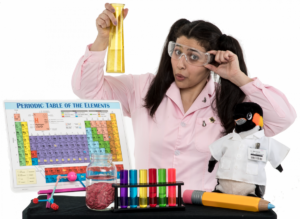
Alumni Feature: Jocelyn Argueta (Jargie the Science Girl)
Originally Published April 1, 2020
I remember meeting DJ at an informational session for YSP. She was wearing a signature science dress and spoke about a program that brought interactive science lessons to the schools surrounding USC. I immediately thought, “Now, THESE are my kind of people!” I emailed her for an application and then went down a rabbit hole looking up science-themed clothing. I was excited about my two discoveries that day.
That fall, I joined YSP as a fourth grade TA at Norwood Elementary. I taught three classes on Fridays, making it the perfect ending to my week. The students captured my heart and inspired me with every “ah-ha!” moment, a million interesting questions, and instances when they challenged themselves to be creative within the experiment. This is how science is supposed to be experienced in a collaborative and fun way. I was proud to be a part of YSP and give back to these communities that don’t always have the resources to showcase science in this way. These are the same communities I grew up in and it was fantastic to see a program creating access to STEM at such a crucial age.
I also gravitated toward YSP because in my spare time I was developing my own form of outreach by combining my love of science and theatre. In 2017, I worked with Phantom Projects Theatre Group to launch “Jargie the Science Girl!” a live, science show that toured around Southern California schools. After a year and a half of workshopping the show in small groups, we expanded and created a larger version fit for the theatre stage. Our national touring show debuted in 2019 at the Smithsonian Institute’s Discovery Theatre, followed immediately by a stop in Edmonds, WA. We grew from sharing our scientific adventure with 100 students to 1,400 per show day. Of course, a big part of our expansion was offering a bilingual version to Spanish-speaking communities. Even with larger audiences, I still feel like I’m teaching in a classroom around USC, showing students that science is fun, creative, and most importantly, within their reach.
Jocelyn Artuega in McMurdo Station, Antarctica on the way to the South Pole and the IceCube Observatory (PolarTREC 2019), Courtesy of ARCUS.
Recently, I was chosen as a PolarTREC educator and spent five weeks in Antarctica working with the IceCube Neutrino Observatory at the South Pole. I packed my pink Jargie lab coat, my penguin lab assistant, and flew south to learn about how scientists do research in one of the coldest, most remote places on the planet. I shared my experience through social media and blog posts, highlighting polar life and IceCube science. Now that I’m home, I plan to continue sharing the South Pole through Jargie and my own talks at schools and libraries. Besides being “cool,” the South Pole is a captivating example of how science expands beyond the walls of a traditional laboratory. It levels a scientist with an adventurer and the best part is that you don’t have to hop on a plane to explore something new. Sometimes the grandest adventure can come from making slime in a Los Angeles classroom.